What's New
Displaying results 2731 - 2740 of 4914
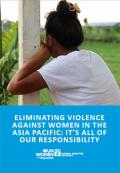
Resource | Publications,
Violence against women has been described as a global issue of 'epidemic proportions', and is perhaps the most widespread and socially tolerated form of human rights violations. Women are affected by different forms of violence at different stages of their lives. These include (but are not limited to) violence by intimate partners and family members, sexual violence, trafficking, femicide (including dowry killings), female genital mutilation, and child or forced marriage.
A world where women are free of the threat of violence is one in which both individual women and the society of which they are a part is better off. Violence against women is not only a gross violation of women's human rights, but causes both a range of financial and health issues for individual victims, and imposes significant economic and social costs on society.
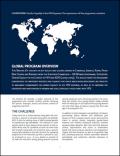
Resource | Publications,
AIDS is the leading cause of death among women of reproductive age worldwide. In addition to their biological susceptibility, HIV disproportionately affects women and adolescent girls because of their unequal cultural, social and economic status in society. Gender inequality, gender-based violence, and harmful traditional practices reinforce unequal power dynamics with men and limit women’s choices, opportunities and access to information, health and social services, education and employment.
This advocacy kit provides key results and lessons learned in Cambodia, Jamaica, Kenya, Papua New Guinea and Rwanda under the European Commission–UN Women programme, "Supporting Gender Equality in the Context of HIV and AIDS (2009–2013)", which demonstrates the important progress and transformational changes that can derive from investments targeted towards implementation of commitments to gender equality. These include policies, programmes and budgets, as well as empowering the leadership and participation of women and girls, especially those living with HIV.
The advocacy kit provides a global overview of the programme and includes country profiles featuring the specific strategies, results and lessons learned in each of the five countries that were part of the programme.
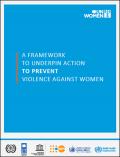
Resource | Publications,
Violence against women is a one of the most pervasive human rights violations in the world, rooted in gender inequality, discrimination and harmful cultural and social norms. It is also increasingly recognized as a public health issue that adversely affects the health of women. It is estimated that approximately 35 per cent of women worldwide have experienced intimate partner physical and/or sexual violence or non-partner sexual violence in their lifetime (WHO, 2013). The prevalence and serious impacts of this violence make it one of the most significant issues to be addressed in our time.
The framework contained in this document draws together contemporary knowledge and practice in violence prevention. Its focus is on addressing the root causes as well as risk and protective factors associated with VAW.

Resource | Publications,
The brochure provides analysis of why money matters in ending violence against women and girls, describes the current funding shortfall and challenges in funding landscape, provides information on what it costs to effectively support efforts to end violence against women and girls using regionally-balanced data, and aims to demonstrate the value of investing in efforts to end violence against women and girls by providing examples of impact from the work of UN Women, grantees of the UN Trust Fund to End Violence against Women, and other civil society organizations.
This briefing also aims to reach out to organizations, United Nations Member States and interested individuals with a strong message that increasing their funding of initiatives can make a critical difference. By contributing to efforts to end violence against women, they can also help remove a major barrier to individual, community and national development.
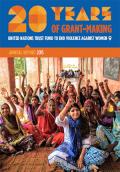
Resource | Publications,
Built upon the generosity of UN Member States and a growing number of private sector partners, the UN Trust Fund is the only global, multilateral, grant-making mechanism that supports national efforts to end violence against women and girls, and its role today is more crucial than ever.
This Annual Report provides an opportunity to celebrate successes in combatting violence against women and girls around the world and to address remaining challenges. Despite the growing recognition that violence against women and girls is a human rights pandemic and a major obstacle to sustainable development, it continues to have an unjustifiably low priority in national planning, programming and budgeting. That is why now is the time to share examples of what works so we can turn talk into concrete action.

Resource | Publications,
Violence in all its forms casts a long shadow over the health of populations and individuals, and several Sustainable Development Goals, notably Goal 5 on gender equality and Goal 16 on peaceful societies, call for efforts to end or significantly reduce violence. Violence affects women, men and girls and boys of all ages.
The plan focuses on violence against women and girls, and against children, while also addressing common actions relevant to all types of interpersonal violence. It also addresses interpersonal violence against women and girls, and against children, in situations of humanitarian emergencies and post-conflict settings, recognizing that such violence is exacerbated in these settings.
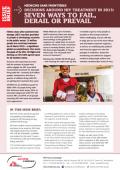
Resource | Publications,
In this issue brief we first review trends in generic competition and intellectual property (IP) licensing for key antiretroviral drugs. We then outline seven momentous decisions to be made in 2015 that will largely determine whether ART will be affordable, available and robust for the next 15 years of treatment scale-up to all people living with HIV. This includes opportunities for greatly improved treatment regimens based on WHO guidelines on when to start treatment, and what first- and second line regimens should include.

Resource | Publications,
The aim of the new initiative is to leverage improved, accessible, affordable and optimally used diagnostic technologies and strategies to ensure achievement of a bold new HIV treatment target for 2020.

Resource | Publications,
This document presents experiences of how community-based antiretroviral therapy (ART) delivery can improve both the level of access to treatment and the quality of health outcomes for people living with HIV. These experiences illustrate that community-based ART delivery is efficient, effective and high quality.

Resource | Data Sheets,
Surveillance of transmitted HIV drug resistance (TDR) in individuals recently infected with HIV was performed following WHO-suggested methods. The prevalence of transmitted HIV drug resistance (TDR) in recently infected antiretroviral drug naïve individuals in PNG has not been fully characterised.





